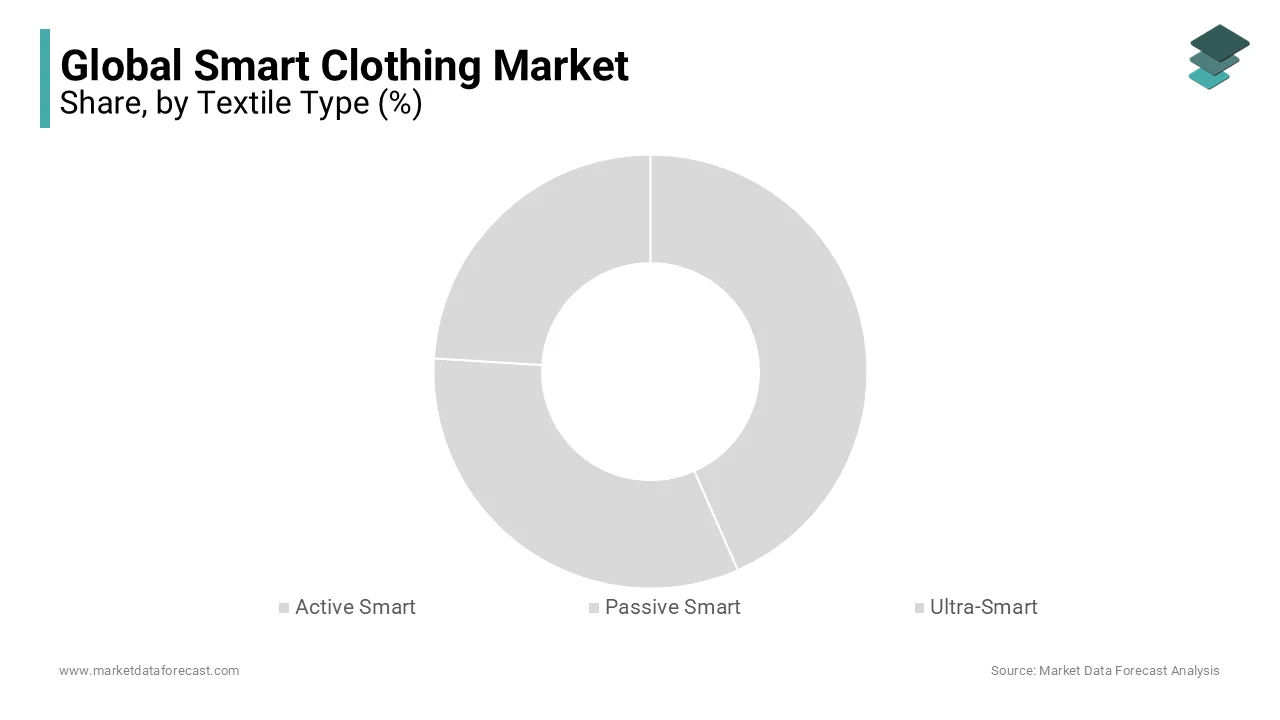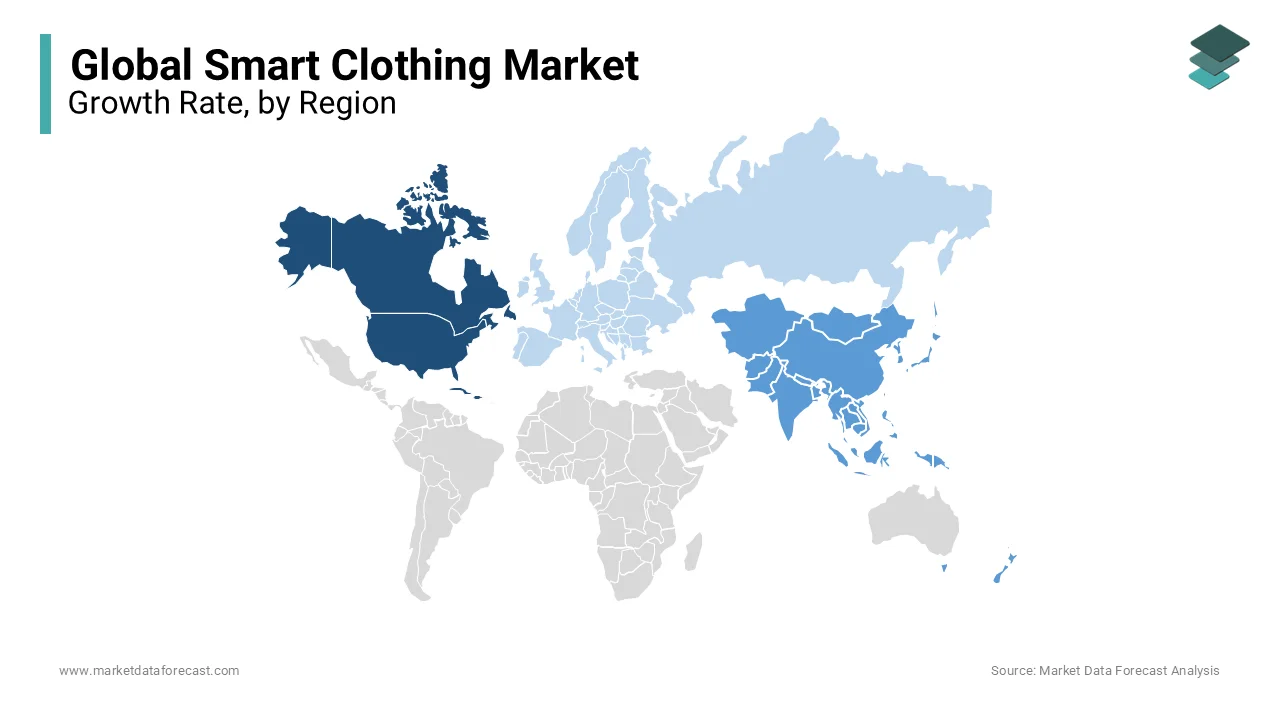Global Smart Clothing Market Size, Share, Trends, & Growth Forecast Report – Segmented by Textile Type (Active Smart, Passive Smart, Ultra-Smart), Product Type (Upper wear, Lower wear, Inner wear, and others), end-user industry (Military & Defense, Sports & Fitness, Fashion & Entertainment, Healthcare) & Region - Industry Forecast From 2024 to 2032
Global Smart Clothing Market Size (2024 to 2032)
The global smart clothing market was worth USD 2.05 billion in 2023. The global market is predicted to reach USD 2.58 billion in 2024 and USD 16.08 billion by 2032, growing at a CAGR of 25.7% during the forecast period.

E-textiles and Smart Clothing are fabrics embedded with ultrathin, flexible and transparent sensors, actuators, mobile connectivity, and nanogenerators for power. Some smart clothes are made from advanced textiles with interwoven circuitry, while others implement sensors and additional hardware to give them smart functionality.
The combination of these components gives smart clothing new functionality, which helps improve its performance and usefulness for the wearer. Bright clothing monitors the wearer’s physical movement. For instance, smart shirts and body suits offer biometric data such as pulse rate, temperature, muscle stretch, heart rhythm, and physical movement, which are transmitted via Bluetooth to an associated app in real-time.
Current Scenario of the Global Smart Clothing Market
Researchers are making use of different materials such as nonmaterial, polymers, dielectric elastomers, and composites for smart clothing. These kinds of textile materials are tailored to specific applications depending on their different characteristics and behavior based on different stimuli. Some smart clothes are made from advanced textiles with interwoven circuitry, while others implement sensors and additional hardware to give them smart functionality. Smart clothing includes smart socks, smart shoes, smart work clothes, smart sleepwear, smart activewear, smart casual wear, etc. These smart clothing are now widely adopted in the Military & Defense, Sports & Fitness, Fashion & Entertainment, and Healthcare sectors. Therefore, fashion with health benefits is fueling the demand for smart clothing in the market during the forecast period.
MARKET DRIVERS
The driving force of the Smart Clothing Market is its wide range of benefits in healthcare, sports and fitness, military, and defense segments, as this clothing helps monitor the wearer's pulse rate, breath rate, temperature, sweat, and dehydration. The rising demand for smart clothing in the sports and fitness segment is fueling the growth of the market. People are concerned about health and fitness and therefore prefer to buy smart clothing such as intelligent shirts, shoes, eyewear, etc., in order to track pulse rate, breathing rate, etc. These wearables or smart clothing are also gaining traction in the healthcare sector in order to monitor biopotentials, breathing movement, cardiac sounds, sweat, dehydration, electrolytes, stress indicators, etc. The increasing investment of sports associations is fueling the demand for smart clothing.
The increasing research and development of sensor-embedded textile fiber or circuitry woven textiles are fueling the demand for smart clothing in the market. They are providing fashion with technology. One of the biggest factors that play a part in the emerging electronic textile industry is the advancement of nanotechnology, due to which intrinsic nanomaterials such as carbon nanotubes, graphene, or non-wires into the textile to get smart clothing, which further drives the growth of the smart clothing in the market.
These smart clothes respond to stimuli or the environment. Therefore, the demand for e-textiles or smart clothing is high in the defense and military sectors. Also, these clothes are highly applicable for fire brigades as they provide safety due to built-in sensors. It also detects external chemical detection such as toxic gases, vapors, etc, thus alerting the wearer about the environment. Moreover, the government is supporting the military and defense sectors in adopting such types of smart clothing for safety, which will fuel the growth of the market in the near future.
MARKET RESTRAINTS
The high cost, along with a lack of awareness about the benefits of smart clothing, is restricting the market's growth.
REPORT COVERAGE
|
REPORT METRIC |
DETAILS |
|
Market Size Available |
2023 to 2032 |
|
Base Year |
2023 |
|
Forecast Period |
2024 to 2032 |
|
CAGR |
25.7% |
|
Segments Covered |
By Textile Type, Product Type, and Region |
|
Various Analyses Covered |
Global, Regional & Country Level Analysis, Segment-Level Analysis, DROC, PESTLE Analysis, Porter’s Five Forces Analysis, Competitive Landscape, Analyst Overview on Investment Opportunities |
|
Regions Covered |
North America, Europe, APAC, Latin America, Middle East & Africa |
|
Market Leaders Profiled |
AiQ Smart Clothing (Taiwan), Athos (US), Carre Technologies (Canada), Sensoria (US), Clothing Plus (Finland), Cityzen Sciences (France), Vulpes Electronics (Japan), DuPont (US), Wearable X (US), Applycon (Czech Republic) and Others. |
SEGMENTAL ANALYSIS
Global Smart Clothing Market Analysis By Textile Type

Based on textile type, the Global Smart Clothing Market is segmented into Active Smart, Passive Smart, and Ultra-Smart. Active smart textiles hold the largest share of smart clothing. This kind of smart textile clothing has the ability to sense and react to stimuli, and due to this property, it helps in most of the applications of the end-user industries. For example, phase-change materials are used for heat storage and transfer, which is why the outfits made from this material are used in sports, firefighting, defense, etc. Textile products become more comfortable when a textile material can react to the environment. Owing to the above factors, the market for active smart textiles is growing rapidly, which will create opportunities for smart clothing market growth in the coming years.
Global Smart Clothing Market Analysis By Product Type
Based on product type, the Global Smart Clothing Market is segmented into Upper wear, Lower wear, Inner wear, and others. The upper wear segment is expected to dominate the market due to increasing demand for upper wear, such as smart shirts, jackets, and vests in various end-user industries. A smart shirt can provide biometric data such as heart rate, breathing rate, muscle activity, etc, which are utilized to optimize performance and planned workouts. With the help of smart clothing, data get captured in real-time and sent to the associated app that provides insights into the range of sporty metrics, which includes intensity & recovery, calories burned, fatigue level and sleep quality, temperature, etc. Owing to the above reasons, the demand for upperwear is rising in industries, which will fuel the growth of the market in the coming years.
Global Smart Clothing Market Analysis By End-users
Based on end-users, the Global Smart Clothing Market is segmented into Military & Defense, Sports & Fitness, Fashion & Entertainment, and Healthcare. The demand for smart clothing is increasing in the sports and fitness industry. The sensor embedded clothing line and innerwear’s are already in the market that is highly adopted by sport and fitness industry. The increasing demand for a sports bra that records running distances, breathing rates, and heart rates along with heated underwear is fueling the demand for sensor-based smart clothing in the sports industry, which in turn boosts the market growth in the forecast period.
REGIONAL ANALYSIS

North America holds the largest share of the smart clothing market due to the sophisticated lifestyle of people in this region and the growing demand for smart sports and fitness wear for monitoring heartbeats, breath rate, etc., fueling the demand for smart clothing. The population concerned in this region is demanding body monitoring technology, so major players are bringing new innovations. Also, the presence of various players in this region is propelling the growth of the market. One of the researchers in the U.S. has developed conductive nanotube fibers that, when woven into clothing, help monitor the heart rate of the wearer.
Asia-Pacific is the fastest-growing region in the global e-textiles and smart clothing market. China is the largest producer and exporter of textiles, holding around 45% of global textile production alone. India, South Korea, and Vietnam are major producers and exporters of textiles in this region. Rising awareness of smart technology and advanced products to improve lifestyle and health are boosting the growth of the market in this region. Moreover, due to growing medical and healthcare concerns in India and China, the market for smart clothing is increasing due to the excessive population and industrial needs.
Europe is also a major exporter of textiles and holds a major share in the global textile export market, along with technologically advanced clothing. The European market is also led by the escalating use of smart fabrics in defense, fitness, and healthcare, which is fueling the demand for smart clothing in this region during the forecast period.
KEY PARTICIPANTS IN THE GLOBAL SMART CLOTHING MARKET
The major companies operating in the global smart clothing market include AiQ Smart Clothing (Taiwan), Athos (US), Carre Technologies (Canada), Sensoria (US), Clothing Plus (Finland), Cityzen Sciences (France), Vulpes Electronics (Japan), DuPont (US), Wearable X (US), Applycon (Czech Republic), and others.
RECENT HAPPENINGS IN THE GLOBAL SMART CLOTHING MARKET
- In January 2022, Vision announced its partnership with leading sports and fitness brands to collaborate on next-generation user experiences that integrate augmented reality, wearable technology, and personal performance data. This partnership will bring unique ways to improve access to data and enhance athlete’s performance during sporting activities.
- In January 2022, Cool, the world’s largest cloud solution for rapid fabric digitalization at scale, announced that it would reveal the world’s first FPGA-based MPSoC (multiprocessor system on a chip) for textile industrial applications in December 2022. This fabric Meta Chip is a collaboration between Frontier. Cool and E-elements.
DETAILED SEGMENTATION OF THE GLOBAL SMART CLOTHING MARKET INCLUDED IN THIS REPORT
This research report on the global smart clothing market has been segmented and sub-segmented based on the textile type, product type, and region.
By Textile Type
-
Active Smart
-
Passive Smart
-
Ultra-Smart
By Product Type
-
Upper wear
-
Lower wear
-
Inner wear
-
Others
-
Socks
-
Beanie
-
Gloves
-
Hats
By End-users
-
Military & Defense
-
Sports & Fitness
-
Fashion & Entertainment
-
Healthcare
By Region
-
North America
-
Europe
-
Asia-Pacific
-
Middle East & Africa
Frequently Asked Questions
How are smart clothing manufacturers addressing concerns related to privacy and data security?
Smart clothing manufacturers are implementing encryption techniques, secure authentication methods, and compliance with data protection regulations such as GDPR and CCPA to address concerns related to privacy and data security.
What are the key technological advancements driving innovation in the smart clothing market?
Technological advancements such as miniaturization of sensors, development of flexible and stretchable electronics, advancements in data analytics and AI algorithms, and integration of biometric sensors are driving innovation in the smart clothing market.
What are the sustainability implications of smart clothing production on a global scale?
Smart clothing manufacturers are increasingly focusing on sustainable production practices, including the use of eco-friendly materials, reducing energy consumption during manufacturing processes, implementing recycling programs for electronic components, and ensuring responsible disposal of end-of-life products to minimize environmental impact.
How do smart clothing products cater to different demographic segments globally?
Smart clothing products are designed to cater to diverse demographic segments including athletes, fitness enthusiasts, elderly individuals requiring health monitoring, professionals seeking smart workwear, and fashion-conscious consumers looking for trendy wearable technology.
Related Reports
Access the study in MULTIPLE FORMATS
Purchase options starting from $ 2500
Didn’t find what you’re looking for?
TALK TO OUR ANALYST TEAM
Need something within your budget?
NO WORRIES! WE GOT YOU COVERED!
Call us on: +1 888 702 9696 (U.S Toll Free)
Write to us: [email protected]